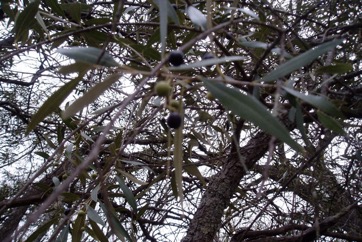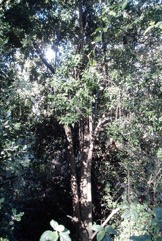Wild olive, Africa Olive

A tropical plant. It can grow on a large range of soils and in many climates. It will grow in alkaline soils. It is drought resistant. It often grows near running water. It grows between 1,499-2,450 m above sea level.
Also known as:
Brown olive, Emuropepe, Golden-leaved olive, Kang'o, Mlamuru, Mohlware, Motlhware, Muguma, Mupfungo, Mutamaiyu, Muthata, Mutiba, Oliviera africana, Swartolien, Swartoleen, Swartolienhout, Umhlwanti, Umnquma, Umquma, Umuunzenze, Weger, Wilde-olyf
Synonyms
- Olea africana Mill.
- Olea chrysophylla Lam.
- Olea buxifolia Mill.
- Olea verrucosa (Willd.) Link.
Edible Portion
- Fruit pulp, Leaves - tea, Flowers
Where does Wild olive grow?
Found in: Africa, Australia, Botswana, East Africa, Eritrea, Ethiopia, Kenya, Madagascar, Malawi, Mozambique, Namibia, Rwanda, Somalia, South Africa, Southern Africa, Uganda, Yemen, Zambia, Zimbabwe
Notes: There are over 20-40 Olea species.
Growing Wild olive, Africa Olive
Cultivation: It is easily grown. It can be raised from seed or hardwood cuttings. Fresh seed should be used. Seeds germinate in 8-12 days. Annual pruning stimulates growth. Commercial olives can be grafted onto it.
Edible Uses: The fruit can be eaten. They are a substitute for olives. The leaves can be soaked in boiling water to make tea. The leaves are used as a condiment.
Production: It is slow growing.
Nutrition Info
per 100g edible portion| Edible Part | Energy (kcal) | Protein (g) | Iron (mg) | Vitamin A (ug) | Vitamin c (mg) | Zinc (mg) | % Water |
|---|---|---|---|---|---|---|---|
| - | - | - | - | - | - |
Wild olive, Africa Olive Photos


References
Bodkin, F., 1991, Encyclopedia Botanica. Cornstalk publishing, p 736
Dale, I. R. and Greenway, P. J., 1961, Kenya Trees and Shrubs. Nairobi. p 348 (As Olea africana)
De Vynk, J. C., et al, 2016, Indigenous edible plant use by contemporary Khoe-San descendants of South Africa's Cape South Coast. South African Journal of Botany. 102 (2016) 60-69
Dharani, N., 2002, Field Guide to common Trees & Shrubs of East Africa. Struik. p 138 (As Olea europea subsp. africana)
Drummond, R. B., 1981, Common Trees of the Central Watershed Woodlands of Zimbabwe, National Herbarium Salisbury. p 188
Facciola, S., 1998, Cornucopia 2: a Source Book of Edible Plants. Kampong Publications, p 163 (As Olea africana)
Fowler, D. G., 2007, Zambian Plants: Their Vernacular Names and Uses. Kew. p 52
Fox, F. W. & Young, M. E. N., 1982, Food from the Veld. Delta Books. p 282
Goode, P., 1989, Edible Plants of Uganda. FAO p 30 (As Olea africana)
Hall, N. et al, 1972, The Use of Trees and Shrubs in the Dry Country of Australia, AGPS, Canberra. p 394
Jardin, C., 1970, List of Foods Used In Africa, FAO Nutrition Information Document Series No 2.p 150
Joffe, P., 2007, Creative Gardening with Indigenous Plants. A South African Guide. Briza. p 105
Kew Bull. 43:69. 1979
Kokwaro, J. O. and Johns. T., Luo Biological Dictionary. p 43
Kunkel,
Lazarides, M. & Hince, B., 1993, Handbook of Economic Plants of Australia, CSIRO. p 173
Molla, A., Ethiopian Plant Names. http://www.ethiopic.com/aplants.htm (As Olea africana)
Palgrave, K.C., 1996, Trees of Southern Africa. Struik Publishers. p 759
Palmer, E and Pitman, N., 1972, Trees of Southern Africa. Vol. 3. A.A. Balkema, Cape Town p 1819
Peters, C. R., O'Brien, E. M., and Drummond, R.B., 1992, Edible Wild plants of Sub-saharan Africa. Kew. p 157
Schmidt, E., Lotter, M., & McCleland, W., 2007, Trees and shrubs of Mpumalanga and Kruger National Park. Jacana Media p 534
Shava, S., 2000, The Use of Indigenous Plants as Food by a Rural Community in the Eastern Cape: an Educational Exploration. Masters Thesis Rhodes University. p 66
Simmonds, N.W., 1979, Olive, in Simmonds, N.W., (ed), Crop Plant Evolution. Longmans. London. p 219
van Wyk, B-E., 2011, The potential of South African plants in the development of new food and beverage products. South African Journal of Botany 77 (2011) 857–868
Venter, F & J., 2009, Making the most of Indigenous Trees. Briza. p 220
von Breitenbach, F., 1985, Southern Cape Tree Guide. Department of Environment Affairs, Forestry Branch. Pamphlet 360 Pretoria p 27
Williamson, J., 2005, Useful Plants of Malawi. 3rd. Edition. Mdadzi Book Trust. p 178
www.zimbabweflora.co.zw 2011
www.worldagroforestrycentre.org/treedb/